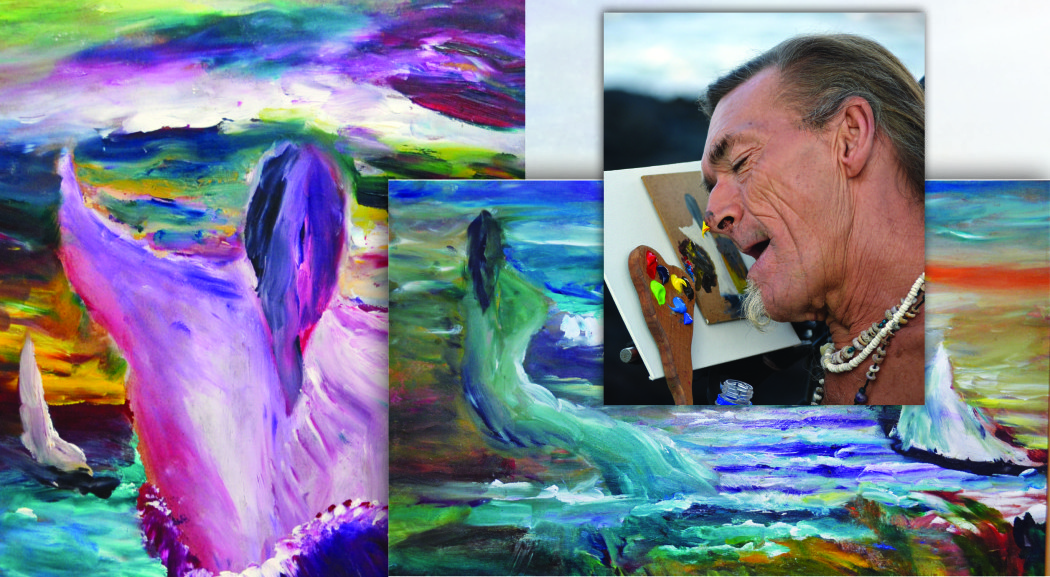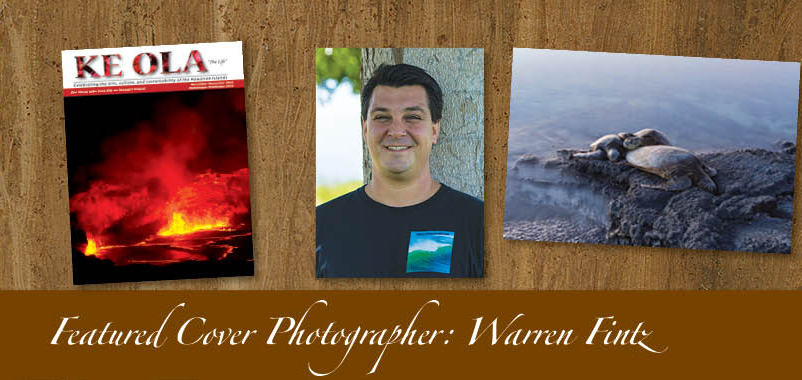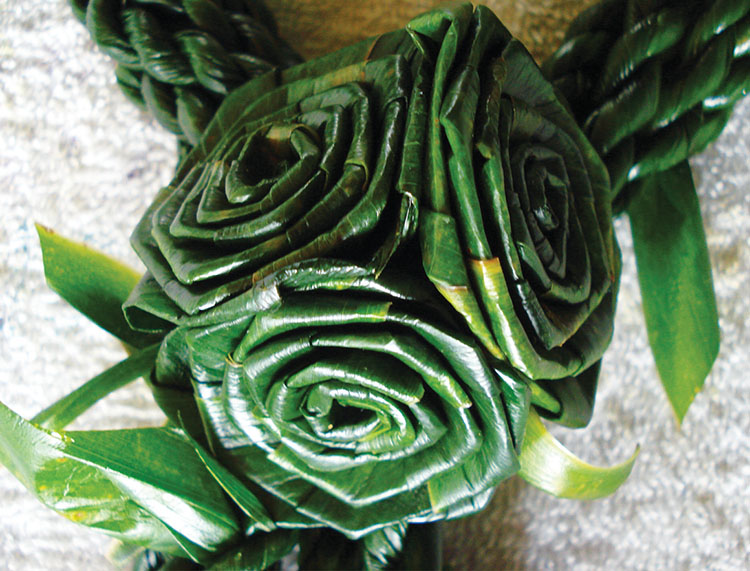Spirits of Ocean and Land: Wayne Levin and Jozuf Hadley Team Up for Multi-Media Exhibit at Kahilu Theater
By Karen Rose
What do a pidgin poet and an underwater photographer have in common?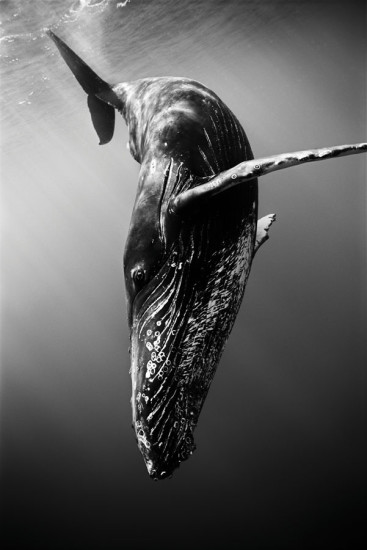
In the case of Wayne Levin and Jozuf Hadley, it’s a love of the spiritual aspects of artistic expression. This fall, the Kahilu Theatre in Waimea presents Spirits of Ocean and Land, a collaboration of Levin’s black and white underwater photography, and Hadley’s sculptures and poetry.
Wayne and Jozuf met in 1974. Jozuf was known for his full body cast sculptures and pidgin poetry, and Wayne for his photography. With funding from the Hawai‘i State Foundation on Culture and Arts, the two joined forces on a project to create photographic slides set to pidgin poetry. After completion of the project, Jozuf moved to Vermont to teach and the two lost touch.
In 2014, more than 40 years after Wayne and Jozuf first collaborated together, the two were reunited by local photographer Kathy Carr, who asked both artists to join the South Kona Artists Collective. When the two discovered they were both asked to be a part of the collective, they looked forward to seeing one another again and rebuilding their friendship.
Upon reunification, they had the idea to do another artistic collaboration and contacted Deborah
Goodwin, Executive Director of Kahilu Theatre, who encouraged them to display their exhibit at the theater.
“Wayne Levin and I are good friends,” says Deborah. “I’ve had the privilege of free diving with him in Kealakekua Bay, and have witnessed first hand how he is able to capture the world under the sea as he does. When I learned his work at the White House was voted the number one best photography exhibit in Washington, D.C. in 2015, I knew we had to bring him back to Kahilu Theatre. I’m so glad he said yes, and brought another Hawaiian treasure with him in Jozuf Hadley.”
Wayne describes Jozuf’s contemporary tribal sculptures as representing indigenous terrestrial spirits, and his images of marine animals as representing spirits beneath the surface of the water. This spiritual commonality is the theme that runs through their new exhibit about terrestrial and aquatic spirits of Hawai‘i.
Photographer Wayne Levin
Born in Los Angeles in 1945, Wayne became interested in photography when his father gave him a Brownie camera and a kit to develop his own film for his twelfth birthday. After high school, he attended Brooks Institute of Photography in Santa Barbara. He left Brooks in 1964 to become more involved in the Civil Rights Movement, and to work with the Congress of Racial Equality and the Mississippi Freedom Democratic Party.
In 1968, he moved to O‘ahu and subsequently took a year and a half off to sail the South Pacific and explore Asia and Europe with camera in hand. Wayne documented his travels through photography, and later took an additional six months to explore Japan, Korea, Mexico, and Central America. The images he captured during his travels became a part of his first exhibit at Gima’s Art Gallery and The Downtown Galleries
in Honolulu.
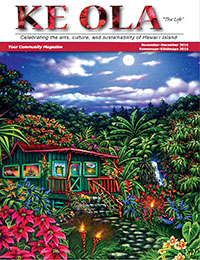
In 1983, after receiving his BFA in photography from the San Francisco Art Institute and his MFA from the Pratt Institute in Brooklyn, he moved back to O‘ahu to teach at University of Hawai‘i Mānoa.
“When I graduated and got a job at the University of Hawai‘i, I purchased an underwater camera as a present to myself,” says Wayne. “I did some color photography of surfers underwater, but I wasn’t very happy with the results. It was murky, and basically the only color I got was blue. I decided to switch back to black and white and it kind of opened everything up. Not only could I really control the contrast, but it also abstracted the ocean and made you question whether you were looking at clouds in the sky or waves in the ocean.”
In 1986, Wayne started the photography program at La Pietra Hawai‘i School for Girls on O‘ahu, where he taught as an artist-in-residence.
A year later he received an Ohio Arts Council artist-in-residence at the Dayton Art Institute. Upon completion of his two year residency, he returned to Hawai‘i Island and at the suggestion of a friend, began photographing dolphins in Kealakekua Bay. Thus began his reconnection with underwater photography.
Since then, Wayne has solidified his reputation as a black and white underwater photographer. His numerous credits include magazine publications, book awards, and exhibits in national and international galleries, including the Museum of Modern Art in New York, Museum of Photographic Art in San Diego, The Contemporary Museum in Honolulu, and the Hawai‘i State Foundation on Culture and the Arts.
“I think color photography relates more to the reality you see,” says Wayne. “With black and white, it’s removed from that reality. It becomes more dreamlike, more emotional, because it’s different from the way we normally see things. I think black and white makes it more surreal.”
In 2009, Wayne was invited by Dr. Randal Kosaki to accompany the research cruise of the NOAA vessel Hi‘ialakai to the Papahānaumokuākea Marine National Monument. One of the
most isolated archipelagos in the world, he was honored to have the opportunity.
“I try to keep a social consciousness going through my work,” explains Wayne. “Sometimes the work is just about beauty or amazement, but when it’s possible, I’m always looking to incorporate some kind of social edge.”
Artist and Pidgin Poet Josuf Hadley
Jozuf Hadley, or Bradajo (Brother Jo) as he is known, creates wood assemblage sculptures that he feels reflects the themes of the indigenous peoples of Oceania though a modern lens. He collects the medium materials in varying locations, from Hawai‘i’s beaches to family attics.
In addition to his sculptures, he also writes and performs poetry in Hawai‘i’s Pidgin English.
“I was moved to collect little bits of wood along the shore lines that had been manipulated in some way by man—so basically, I collect stuff,” explains Jozuf. “A number of my pieces are reflective of what we call ‘Tiki’ or ancient Hawaiian temple carvings.”
Born on Kaua‘i, Jozuf developed his love of nature, music, arts, and the spirituality of ancient Hawai‘i through his mother. He considers his art a pursuit of magic that allows him to imagine an arrangement of natural objects and salvaged goods, thereby create pieces from those materials.
Jozuf’s mother was a librarian on Kaua‘i for 45 years and he credits her with influencing and encouraging his interest in ancient Hawai‘i. However, it was his enrollment in art history courses at the university that solidified his appreciation for the depths of human creativity.
Jozuf credits the beginning of his spoken word creations to an experience he had in the summer of 1969, while doing graduate work in sculpture at the University of Hawai‘i Mānoa. He and three of his friends climbed Alakai Swamp Trail on Kauai‘i with the goal of following one of the tributaries into the swamp. After a couple of days of intense climbing, Jozuf’s friends were ready to quit.
“We had reached an impasse where there was a vertical moss covered wall, and we could hear a waterfall on the other side. I thought maybe it was a way to get into the swamp, so I went by myself,” says Jozuf.
On his solo adventure, Jozuf experienced what he described as an epiphany—a powerful soul drenching awakening that moved him to start writing pidgin poetry.
Pidgin languages are grammatically simplified languages that develop out of necessity between two or more groups of people that have no language in common.
Hawaiian Pidgin is no longer considered a pidgin language, rather a legitimately recognized language that evolved from real pidgin languages once spoken among different ethnic groups in Hawai‘i. Hawaiian Pidgin is now an official language in its own right—a true “lingua franca” or fusion of languages into one distinct tongue.
“I call my pidgin voice ‘Bradajo’—all one word,” says Jozuf. “That’s what my foster father called me when I was a teenager because I would erupt into this crazy pidgin. I write my poetry in bold cursive with a wide, black pen. It was a vision that came to me, and it reflects my unconscious sense of how we talked on the playground among my multi-ethnic classmates.”
Jozuf has created six books and 10 CD recordings during the past 40 years, and will have some of them on hand at opening night of the exhibit at Kahilu Theatere.
“End the end, we just have to listen quietly and something creative will happen,” he says. “When we reach that point, it brings us to a place that has no words. It’s the mystical part of ourselves. It’s a part of who we are. I tap that part of myself, and somehow it comes out in pidgin. I don’t know why, it just does.” ❖
The opening reception for Spirits of Ocean and Land is Thursday, Nov. 10 from 5–7pm. The exhibit closes Wednesday, Dec. 21. Accompanying this exhibit is “Transcending Palms,” featuring award winning fiber artist, Shelley Hoist.
Contact Kahilu Theatre: KahiluTheatre.org
Contact photographer Wayne Levin: WayneLevinImages.com
Contact writer Karen Rose: island.girl.rose@gmail.com
